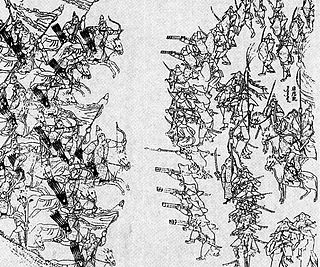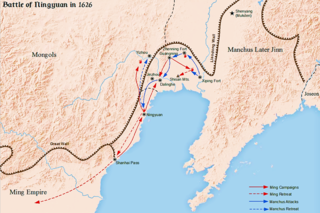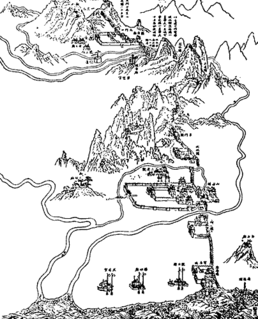Related Research Articles

The Battle of Sarhū refers to a series of battles between the Later Jin dynasty and the Ming dynasty and their Joseon allies in the winter of 1619. The battle is notable for the heavy use of cavalry by the Later Jin in defeating Ming and Joseon forces equipped with hand cannons, cannons, and matchlocks.

The Later Jin invasion of Joseon occurred in early 1627 when the Later Jin prince Amin led an invasion of the Joseon Dynasty. The war ended after three months with the Later Jin establishing itself as sovereign tributary overlord over Joseon. However Joseon continued its relationship with the Ming Dynasty and showed defiance in solidifying its tributary relationship with the Later Jin. It was followed by the Qing invasion of Joseon in 1636.
The Seven Grievances was a manifesto announced by Nurhaci, khan of the Later Jin, on the thirteenth day of the fourth lunar month in the third year of the Tianming era of his reign; 7 May 1618. It effectively declared war against the Ming dynasty.

The Battle of Ningyuan was a battle between the Ming dynasty and the Later Jin dynasty in 1626. The Later Jin had been waging war on the Ming for several years, and their leader Nurhaci had deemed Ningyuan to be a suitable target for his attack, in part due to advice from a Ming defector, Li Yongfang. Later Jin failed to take the city and Nurhaci was wounded in the assault, dying eight months later. The Ming emerged victorious, marking a temporary resurgence of the Ming army after an eight-year-long series of defeats.

Nurhaci was a Jurchen chieftain who rose to prominence in the late 16th century in Manchuria. He was a member of the House of Aisin-Gioro, and reigned as the founding khan of the Later Jin dynasty of China from 1616 to 1626.

The transition from Ming to Qing, alternatively known as Ming–Qing transition or the Manchu invasion of China, from 1618 to 1683, saw the transition between two major dynasties in Chinese history. It was a decades-long conflict between the emerging Qing dynasty, the incumbent Ming dynasty, and several smaller factions. It ended with the consolidation of Qing rule, and the fall of the Ming and several other factions.
The Battle of Dalinghe was a battle between the Later Jin dynasty and the Ming dynasty that took place between September and November 1631. Later Jin forces besieged and captured the fortified northern Ming city of Dalinghe in Liaoning. Using a combined force of Jurchen and Mongol cavalry, along with recently captured Ming artillery units, the Later Jin khan Hong Taiji surrounded Dalinghe and defeated a series of Ming reinforcement forces in the field. The Ming defenders under general Zu Dashou surrendered the city after taking heavy losses and running out of food. Several of the Ming officers captured in the battle would go on to play important roles in the ongoing transition from Ming to Qing. The battle was the first major test for the Chinese firearms specialists incorporated into the Later Jin military. Whereas the Later Jin had previously relied primarily on their own Eight Banners cavalry in military campaigns, after the siege of Dalinghe the Chinese infantry would play a larger role in the fighting. Unlike Nurhaci's failed siege at the Battle of Ningyuan several years prior, the siege of Dalinghe was a success that would soon be replicated in Songshan and Jinzhou, paving the way for the establishment of the Qing dynasty and the ultimate defeat of the Ming.
Kong Youde was a Chinese adventurer and Ming dynasty military officer who served under the warlord Mao Wenlong until Mao's death in 1629. Subsequently he worked for Sun Yuanhua, governor of Shandong, along with fellow Mao subordinate Geng Zhongming. When ordered by Sun to reinforce Zu Dashou at the Battle of Dalinghe in 1631, Kong and Geng mutinied, pillaging the countryside, sacking Dengzhou, and subsequently defecting to the Manchu—soon to declare themselves China's Qing Dynasty—in 1633. They were joined in 1634 by another former officer under Mao, Shang Kexi. Together, the three were known as the "Three Miners from Shandong" and participated in many campaigns under the Qing dynasty, hastening the demise of the Ming.

The Battle of Fushun was the first military conflict in the war between the Jurchen-led Later Jin and the Ming dynasty. The battle ended in a decisive victory for the Later Jin and resulted in the capture of Fushun and two other nearby fortresses.
The Battle of Qinghe was a military conflict between the Jurchen Later Jin and Ming dynasty in the summer of 1618. The battle ended with the Jin conquest of Qinghe despite taking heavy casualties.

The Battle of Kaiyuan was a conflict between the Later Jin and Ming dynasty in the summer of 1619. Following the victory at the Battle of Sarhu, Nurhaci continued the attack on Ming by assaulting the city of Kaiyuan.

The Battle of Xicheng was a military conflict between the Yehe Jurchens, their Ming allies, and the Later Jin. In the fall of 1619 Nurhaci invaded Xicheng, the home of the Yehe Jurchens. Nurhaci personally led the vanguard and took the east wall. After capturing the city the Yehe inhabitants were spared, but their Ming allies who had fought beside them were executed.

The Battle of Shen-Liao was a military conflict between the Later Jin and the Ming dynasty. In early 1621 Nurhaci, khan of the Later Jin, invaded Liaodong and captured the cities of Shenyang and Liaoyang from the Ming.

The Battle of Fort Zhenjiang was a military conflict between the Later Jin and the Ming dynasty. In the fall of 1621 Ming general Mao Wenlong captured Fort Zhenjiang on the border of the Jin-Joseon border and held it against multiple Jin assaults before retreating. Nurhaci burnt down the fort afterwards rather than risk having it captured again.

The Battle of Guanging was a military conflict between the Later Jin dynasty and the Ming dynasty in 1622. It occurred at and around the Ming's northern city of Guangning, which fell to the Later Jin in 1622.

The Battle of Ning-Jin was a military conflict between the Later Jin and Ming dynasty. In the spring of 1627, the Later Jin khan Hong Taiji invaded Ming territory in Liaoning under the pretext of illegal construction on Later Jin lands.
The Jisi Incident was a military conflict between the Later Jin dynasty and the Ming dynasty, named because it happened in 1629, a jisi year according to the Chinese sexagenary cycle. In the winter of 1629 Hong Taiji bypassed Ming's northeastern defenses by breaching the Great Wall of China west of the Shanhai Pass and reached the outskirts of Beijing before being repelled by reinforcements from Shanhai Pass. The Later Jin secured large amounts of war material by looting the region around Beijing. This was the first time Later Jin forces had broken through the Great Wall into China proper since they rose up against the Ming dynasty.
Li Yongfang was a Chinese general of the Ming dynasty and Qing dynasty known for defecting to the Qing dynasty, due to the Ming dynasty losing the city of Fushun in Liaoning to the Qing. Li Yongfang along with many other Han Chinese defected to the Qing as the old Ming system was declining and corrupt, and the Qing provided an opportunity for the Han Chinese to continue their culture. One of Li Yongfang's descendants Li Shiyao was sentenced to death by the Qianlong emperor but was spared his life when he helped suppress the Lin Shuangwen rebellion in Taiwan.

The Chahar–Jurchen War was a military conflict waged between the Chahar Mongols and the Jurchen-led Later Jin dynasty and several other Mongol groups from 1619 to 1634.

The late Ming peasant rebellions were a series of peasant revolts during the last decades of the Ming dynasty lasting from 1628–1644. They were caused by natural disasters in Shaanxi, Shanxi, and Henan. At the same time, the She-An Rebellion and Later Jin invasions forced the Ming government to cut funding for the postal service, which resulted in the mass unemployment of men in the provinces hit hard by natural disasters. Unable to cope with three major crises at the same time, the Ming dynasty collapsed in 1644.
References
- ↑ Wakeman 1985, p. 63.
- ↑ Swope 2014, p. 24.